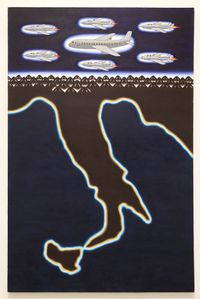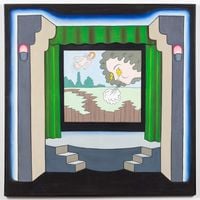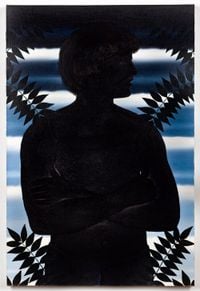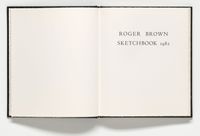Roger Brown was born on December 10, 1941, and was raised in Hamilton and Opelika, Alabama. A number of early experiences and observations in his formative years made deep impressions on Brown. By nature he was creative, and his parents encouraged his artistic bent. Brown’s interest in art emerged in grade school; he took art classes from second to ninth grade, and won first prize in a statewide poster competition in tenth grade. During childhood Brown grew especially close to his grand and great-grandparents, instilling an early interest in his family’s origins, which later flowered in extensive research into his family’s genealogy. Brown developed a deep interest in the material culture of the South, especially for folk art and hand made, functional objects. In adolescent and teen years he was influenced by the aesthetic of the comics, theatre architecture and interiors, and streamlined Art Deco and machine-age design. His religious upbringing in the independent, fundamentalist Church of Christ, was formative and lasting. In later years Brown became an astute and intuitive collector. Memories of his early experiences can be seen as his first, and perhaps most important collection. He retained them, distilled them into their essential aspects, and they became the visual and psychological engine for much of his work throughout his career.
Read MoreAfter graduating from high school in 1960 Brown attended David Lipscomb College in Nashville, a school associated with the Church of Christ, where he briefly pursued an interest in becoming a minister. In 1961 he decided to attend art school, and in the fall of 1962 he moved to Chicago where he first took classes at the American Academy of Art before enrolling at the School of the Art Institute of Chicago (SAIC). His first experience at the School was brief, and in 1963 he returned to the American Academy of Art, where he completed a commercial design program in 1964. He then returned to SAIC as a full-time student from 1965-1970, where he committed to a fine art focus that he would pursue with great intensity and originality for the next three decades. In 1968 Brown received his Bachelor of Fine Art and in 1970 he was awarded his Master of Fine Art, both from SAIC. With his MFA Brown also received Edward L. Ryerson Traveling Fellowship, which supported travels throughout Europe and Egypt, where he collected objects, images, and inspiration. Travel was to figure prominently as a source for inspiration and subject matter throughout Brown’s artistic career; experiences throughout the U.S. and in Mexico, Europe, Russia, and Africa found expression in several paintings. Although Brown left the South for Chicago, he never severed his connection with the region. His life can be viewed in terms of successive regional experiences, strong senses of place, that contributed to his evolving artistic identity and his work.
Chicago: At SAIC Brown was introduced to a range of art historical periods and genres. He gravitated to Pre-Renaissance Italian art, Surrealism, American artists Edward Hopper, Grant Wood, and Georgia O’Keefe, and tribal art of many cultures, as well as to the legendary Maxwell Street market, antique and thrift stores, amusement parks, and other places of visual and cultural interest. During this time Brown was engaged in the emergence of an energetic environment of art-making in Chicago which became known as Chicago Imagism. Inspired by instructors Ray Yoshida and Whitney Halstead, works by Roger Brown and a number of fellow students were initially recognised and supported by curator Donald L. Baum, who organised influential exhibitions at the Hyde Park Art Centre and the Museum of Contemporary Art. In 1972 Brown was featured in the book Fantastic Images: Chicago Art Since 1945 by Franz Schultz.
Encouraged by Yoshida and Halsted, Brown and his colleagues began to look to the work of self-taught artists, visiting Joseph Yoakum, Aldo Piacenza, William Dawson, Lee Godie, and others, responding to their works with a spirit of visual and intellectual curiosity and genuine respect, and ushering them inside the cultural arena, not to an outsider realm. Brown became an ardent champion for the validity of such works, as equal or superior to works from the mainstream. Exploring and documenting art environments and the vernacular landscape became an ongoing pursuit.
In 1971 art dealer Phyllis Kind first exhibited Brown’s work, beginning their strong relationship as the exclusive representative and supporter of his work for his entire career. Life in Chicago marked Brown’s official entry into the 'art world', a realm he flourished in and the subject of his continual, adamant critique. Collecting art and objects that functioned as source materials for his work coalesced into a practice and discipline that was shared by other artists, and reflected a collecting sensibility in Chicago.
In 1972 Brown met architect George Veronda (1940-1984) and the two formed a strong artistic and personal relationship. In 1974 Brown purchased an 1880s storefront building in Chicago; rehabbed by Brown and Veronda, 1926 North Halsted Street became his first home, studio, and collection environment.
Michigan: Brown commissioned Veronda to design a home and studio for a Lake Michigan dunes property he purchased in New Buffalo, MI. The modernist home, studio, and guest house were completed in 1979. Brown divided his time between Chicago and New Buffalo, where he assembled a second collection of art and objects. Veronda was diagnosed with lung cancer in 1983 and died in 1984. Brown continued to live in the award-winning New Buffalo residence, while maintaining his home and studio in Chicago.
Brown’s media eventually included sculpture of found, assembled, and painted objects, theatre and opera sets, and mosaic murals, in addition to painting and printmaking. In 1979 he designed sets for the Chicago Opera Theatre’s production of Mozart’s Cosi fan Tutte. Brown’s critical acclaim grew in the 1970s and 80s. He became known for responding adroitly to the fabric of 20th Century life, through works that addressed a range of subjects and issues, including: natural, architectural, and urban landscapes, the dichotomy of nature and culture, disasters of all types, current and political events, social, religious, and popular culture, autobiographical, personal, and sexual issues, the art world in many guises, cosmology, mortality, history, mythology, transformation, transportation, and the weather. In 1991 his Italian glass mosaic murals, Arts and Sciences of the Ancient World: The Flight of Daedalus and Icarus and Arts and Sciences of the Modern World: La Salle Corridor with Holding Pattern were installed on the façade and in the lobby of the Ahmanson Commercial Development Company (a subsidiary of Home Savings of America, at 120 North LaSalle Street, Chicago. His third (untitled) mosaic mural is a tribute to the African burial ground at the Foley Square Federal Building at 290 Broadway, New York City, dedicated in 1995. In September 1997 the mosaic mural Hull House, Cook County, Howard Brown: A Tradition of Helping, designed by Brown, was dedicated at the Howard Brown Health Center in Chicago.
Brown’s exhibition history is extensive. He was represented by the Phyllis Kind Gallery in Chicago and New York, and his work was shown in numerous solo and group exhibitions around the country and abroad. Major retrospectives of his work were mounted at the Montgomery Museum of Fine Arts in 1980, and at The Hirshhorn Museum and Sculpture Garden in 1987. His last solo exhibition of paintings was in 1997 at Phyllis Kind Gallery in Chicago. He is represented in many major museum collections including the Art Institute of Chicago, Museum of Contemporary Art (Chicago), Metropolitan Museum of Art, Whitney Museum of American Art, Museum of Modern Art, Corcoran Gallery of Art, High Museum of Art, Milwaukee Art Museum, and the Scottish National Gallery of Modern Art.
California: In the late 1980s Brown searched for a place to develop a winter studio on the west coast. He found property in the beach town of La Conchita, north of Ventura, and in 1993 his home and studio, designed by Stanley Tigerman, was completed. Brown adapted his work and collecting disciplines to Southern California. Still addressing a broad range of subjects in his works, Brown created condensed, serial works that focused on California experiences, including a series of ominous cloud-scapes, paintings of rose trees and shrubs, 27 Virtual Still Life object paintings, and metaphorical explorations of bonsai. Aware of his mortality (Brown lived with HIV/AIDS for nearly a decade), many of Brown’s works from 1995 to 1997 evoke the uncanny feeling of a prelude to a different dimension.
Roger Brown’s rich artistic career was at once intensely original and personal. In addition to his consistent and enormously prolific life as an artist, Roger was deeply involved in the research of his family’s genealogy, tracing his lineage prodigiously, and discovering relationships to Elvis Presley and Tallulah Bankhead within his family tree. Roger Brown died on November 22, 1997, and was survived by his parents, James and Mary Elizabeth Brown and his brother Greg Brown.
Alabama: In 1997 Brown was in the process of developing a fourth home/studio/collection environment in an 1870s stone house in Beulah Alabama, so he could 'come full circle' and have a home back in Alabama. He died before the project was realised. His parents and brother renovated the house and opened the Roger Brown Rock House Museum in 1999.
The School of the Art Institute of Chicago became the primary repository for Brown’s personal, professional, and artistic effects. In 1995 he gave the School his New Buffalo, MI retreat, which SAIC operates as a residency facility for faculty and staff. In 1996 he gave SAIC his Chicago collection, which was formalised into the Roger Brown Study Collection, a house museum, archive, and special collection in 1997. Brown bequeathed his home and collection in La Conchita, CA, and a large collection of paintings, to the School.









